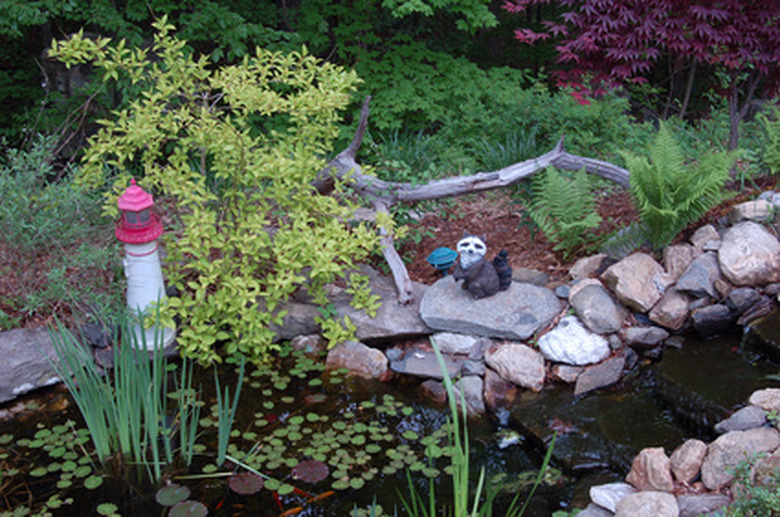Plants To Landscape Around A Small Garden Pond
Play up your garden pond's beauty by landscaping the surrounding area with complementary plants and flowers. Emphasize the water's cool serenity with soft textures and understated colors to create an oasis on hot summer days. For a bolder approach, use plants with striking features and rich color throughout the seasons. Whether you choose the subtle approach or a grand design, appropriate plants turn a small pond into a big feature in your overall garden landscape.
Step 1
Plants that thrive with their roots and crown submerged in shallow water are ideal for the pond's edge. The spiked leaves of dwarf cattail (Typha minima) grow only 2 feet high, an ideal scale for adding height to a small pond. Their elongated, fuzzy, brown flower clusters linger on the tips of rigid stems into the cooler months, adding interest to your winter garden. The shiny, rounded leaves of yellow marsh marigold, also known as cowslip (Caltha palastrus), are an attractive foil to sharp, long-leaf plants. Plant marsh marigold on the boggy edges of the pond where the plants grow 1 to 2 feet high and blossom with buttercup-like flowers in the spring.
Step 2
Small Trees
Step 1
Trees with slender trunks and delicate leaf structures draw focus to your garden pond without overshadowing its small size. A Japanese maple (Acer palmatum) set 3 to 4 feet from the pond's edge provides dappled shade in the summer and a burst of bright autumn-colored leaves in the fall. Select smaller cultivars such as Red Filigree Lace, which typically reaches just 6 feet high, and Waterfall, which grows 7 to 10 feet tall and has gracefully cascading branches. To add springtime flowering beauty to the pond setting, plant a flowering crabapple tree (Malus species). Choose a compact variety like David that grows 12 feet high and blooms early in the season, or a weeping variety such as the pink-blossomed Louisa.
Step 2
Step 3
- Plants that thrive with their roots and crown submerged in shallow water are ideal for the pond's edge.
- The spiked leaves of dwarf cattail (Typha minima) grow only 2 feet high, an ideal scale for adding height to a small pond.
Evergreen Plants
Step 1
A collection of evergreens planted around a small pond keeps the landscaping low-maintenance. A layer of mulch to suppress weeds, plus occasional pruning to maintain the plants' shape and size, is often sufficient to keep the area looking well-manicured. Shrubs in the boxwood (Buxus) family that thrive in moist, well-drained soil include the 2-foot-high Green Gem; the globe-shaped Green Velvet, which can reach a height of 3 feet at maturity, and the upright Green Mountain boxwood, which grows up to 5 feet tall. A blend of evergreens with different color tones and textures reflect the water's changing hues. Place golden arborvitae (Thuja occidentalis Golden Globe) next to pyramid-shaped Blue Prince or Blue Princess holly (Ilex x meserveae), then surround the grouping with low-growing, purple-leaf wintercreeper (Euonymus fortunei Coloratus) for a panoply of subdued colors.
Flowering Plants
Step 1
Small, flowering shrubs set back a foot or two from the garden pond's edge add dimension. The Carol Mackie daphne cultivar (Daphne x burkwoodii) grows 3 to 5 feet high, has white-edged green leaves and fragrant blossoms to scent the area around the pond. Japanese pieris (Pieris japonica) with its red-toned new growth, leathery green leaves and pendulous clusters of spring flowers does well on a shaded side of the pond. For a simple, classic pond landscape, plant a clump of Siberian iris on a low, well-drained mound of soil near the water. Encourage butterflies, drawn to the small pond's water, to stay in the area with butterfly-friendly perennials, such as purple coneflower (Echinacea purpurea), asters, lavender and yarrow (Achillea filipendulia).
Step 2
- A collection of evergreens planted around a small pond keeps the landscaping low-maintenance.
- A layer of mulch to suppress weeds, plus occasional pruning to maintain the plants' shape and size, is often sufficient to keep the area looking well-manicured.
